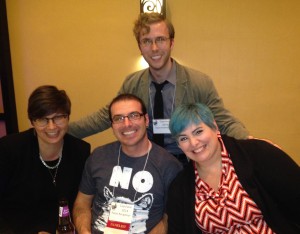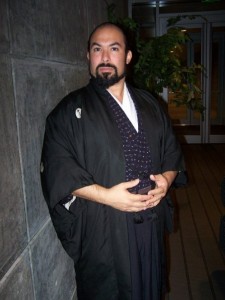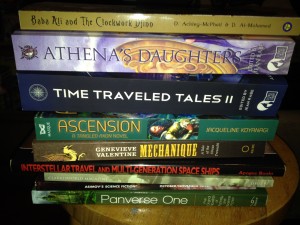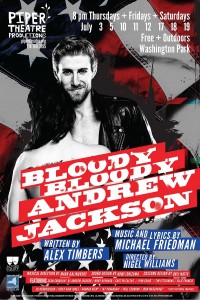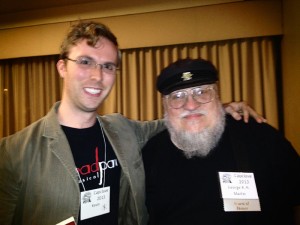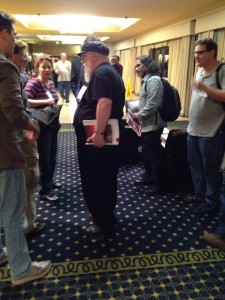Lance Hewett directs Isle of Shoals’ entirely haunting rendition of The Runner Stumbles, a play by Milan Stitt. It appears in repertory alongside the original musical adaptation by Hewett and Bryan Williams, Edward the Second, and shares all but two actors.
The play runs through November 1st, and you won’t want to miss it. Above and beyond being an extremely satisfying theatrical experience, this show is also the perfect autumnal diversion – guaranteed to raise the hairs on the back of you neck and send shudders down your spine.
See this show if you’d like to get properly creeped out in time for Halloween, and if you’re looking for something to carry in your heart with you forever.
(Also, once you’ve seen it, don’t forget to vote on it for a New York Innovative Theatre Award!)
In The Runner Stumbles, Hewett offers us a brilliant examination of themes in juxtaposition, the main ones being: Guilt versus Innocence, Virtue versus Sin, Truth versus Contradiction, and Love versus Murder. This examination causes us to reconsider our own notions of these topics like a teacher leads a student: not by simply prescribing answers, but by providing the right questions so that we may suss out meaning on our own, and learn it all the more by having lived the journey.
And what a journey to live!
At its heart, The Runner Stumbles is a whodunit mystery. We spend most of the show trying to decide who and what we can trust, which is a lot of fun. To illustrate the story, we’re pulled back and forth across time and space a lot, and the protagonist/time-traveller who we follow is named Father Rivard, played by Jonathan French. That means French has to change energies, rhythms, moods, and tones at the drop of a hat – something which he makes look easy, even though it’s anything but.
At the start of one scene, French paces twice across the stage, and somehow he manages to convince me he’s been pacing for hours. It was so natural, so quick, I almost didn’t even realize he did anything at all. French’s character is a boiling stew-pot of internal conflict, and it’s a sheer thrill to watch him steadily bring the temperature up and up and up. In my mind he held back almost too much for the first part of Act I, but by its end – and definitely for all of Act II – French is flawless.
Amara Haaksman plays the radiant Sister Rita, the embodiment of Life itself – complete with all of its marvel as well as all of its faults. She and French achieve a supremely connective onstage chemistry. As they argue, you can feel the subtext strangling your heart even as the text-text meanders off in a completely unrelated direction. In and around their every interaction, you can sense them punishing each other like unhappy lovers. It’s a joy to watch.
The most natural performer onstage had to be Judi Polson. Her character, the simplistic, stock, token-Mid-Westerner, Mrs. Shandig, ends up defying your every thought and expectation. Somehow, despite that, she’s fantastically realistic and utterly convincing. A truly marvelous performance.
Stephen Ryan nails his role of Toby Felker, Father Rivard’s unorthodox legal counsel. With nothing more than a well-timed flash of his eyes, Ryan had us rolling with laughter. This extremely versatile actor shines brightly throughout his arc, inviting us, tricking us, changing us – a magician of theatricality.
The part of Monsignor Nicholson is wisely given to Arthur Lundquist. His smarminess is so deliciously smarmy! When he says the line, “Are you all hiding something from me?” the smile on his face will make your skin crawl.
Jacqueline Rosa plays Erna Prindle, who has the honor of turning herself onstage into the emotional ammunition which Father and Sister use to batter one another. She’s not just caught in the crossfire, she becomes the crossfire. And her later breakdown, at the hands of the relentless prosecutor played by Paul Chamberlain, is carefully measured and adroitly delivered.
Though the entire show is very well done overall, I did notice a gentle accrual of tiny lapsed details which hampered certain effects. There was a dinner freshly set that went completely untouched (almost certainly intentionally, but still I found it distracting). There was the line, “I don’t have time for tea,” said as the teacup is picked up and a cookie is dunked into it. Another spoken line referenced a letter, but the actor’s physicality displayed reading glasses instead. At one point a hand reached out to receive an offered object instantly, as opposed to in response, which would be more natural. Some of the sound effects came in and out a bit abruptly, and I don’t know anyone who uses a flask who can almost take a drink from it, but then put it away. (I’m reminded of the ancient rule of the theatre: “If you show a gun in Act I, it has to go off by Act II.”)
And finally, when Father Rivard first accidentally blurts out the revelation of his true, secret feelings, what probably should have been an incredibly profound moment slips past with noticeably little impact. I can’t decide on exactly why that happened, but my instincts tell me it had to do with a team effort to build up the proper momentum, and to react to it accordingly.
The piece does feel a little dated when it comes to its agenda in dealing with the definition of “Catholicism,” since the issues at hand are mostly from a by-gone era – the early 1900s. That’s fine in regard to general philosophical exploration, however it might make the show a little less accessible to some audiences.
The Runner Stumbles is a wonderful example of what happens when a powerful script falls into the hands of a highly capable cast and crew. When the lights came up for the bows, I was so caught up in the complex spiderweb of feelings that Hewett and his team had spun that I was certainly not emotionally ready to clap and smile and rejoice, and I might not be ready for some time.
But that’s what you get when you witness great theatre – it touches your soul.
